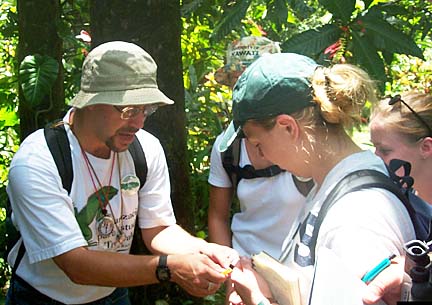


Hawaii violet A violet that was widespread on four Hawaiian islands and documented in numerous collections for 400 years has largely disappeared, an Ohio University botanist has discovered.
nearly gone,
botanist finds
The Ohio University scientist
finds only a small population
of a once-common violetBy Helen Altonn
haltonn@starbulletin.com"We searched and searched for it and found one small population of it on Kauai," Harvey Ballard, an international authority on violets, said in a telephone interview.
The species -- viola tracheliifolia -- was once seen throughout Kauai, Oahu, Molokai and the Big Island, he said, speculating that shrubs and trees moving into natural areas have wiped it out.
The ones he found were in a tiny area near Alakai Swamp that wasn't completely covered by lantana bushes, he said.
"That being the most common violet in the Hawaiian Islands and locating it in only one place makes one start worrying."
He said it was "pretty staggering to me because every indication was it should have been widespread and common everywhere we went ... It's not there in all of the sites where it was before.
"It's gone from widespread and fairly common to being very rare, at least in areas we searched, in a matter of a few decades."
Ballard and Morgan Vis, assistant professors of environmental and plant biology, led a three-week expedition here with four students as part of Ohio University's Global Studies in Plant Biology Program.
They came to the isolated Hawaiian archipelago to study diverse plants that can tell them more about the origins and evolution of plant life.
It's also important to study and conserve rare plants because they could be valuable for medicinal or other uses, Ballard said.
For example, it's now known that the endangered rose periwinkle can treat childhood leukemia, he said.
Ballard collected DNA samples of violets to determine what varieties have become established in the islands and whether they threaten rare and endangered species. His work is supported by the National Science Foundation.
Vis, who studies algae populations, said she was surprised to find a high diversity of algae in some streams. She identified nine different species in one stream on Kauai, she said. "It's some of the highest diversity I've seen."
Even in North American streams with high diversity of algal species, she said, "Usually we get three or four."
She added, "Since this is an oceanic island, where algae are not tolerant of sea water, I didn't expect diversity, but luckily I did get that." She said the nine species are in a high-quality stream near Kapaa with lots of different habitat.
Vis said she is collaborating with Alison Sherwood, University of Hawaii postdoctoral fellow in botany, who will collect more samples for research.
They found a lot of material for genetic studies, she said.
"What we will be looking at is diversity of particular species within a stream and among streams on the same island, and among islands, to kind of compare whether an organism species went from one island to the next, or if there were multiple introductions of it," Vis said.
Ballard also had some surprises. An important species he had hoped to find is described in literature as an open bog violet, he said.
"It was quite a surprise to go into open bogs and not find it at all. We found it in thickets and swampy forests and even in mosses climbing up trees."
The violet lives mostly in higher elevations of Alakai Swamp, with a small variety in a low-elevation bog, Ballard said.
It also was discovered recently in a few places at the summit of the Koolau mountains on Oahu, although some people think it may be a different species, he said.
He said the students "learned a tremendous amount."
"It was an eye-opening experience for them," he said.
They collected plant samples in coastal areas, mountains, swamps, and dry and wet forests on Oahu, Kauai and the Big Island.
They worked from dawn to dusk and several hours into the night most days, wading in water and climbing volcanic cones, he said.
"It was worth it ... a wonderful experience. It is just a fascinating place."
Ballard said he'll continue studying plants in Hawaii over the next decade. "My next goal is to spend a couple months to get up into the high elevations on Oahu, and we need to get to Molokai and Maui," he said.
He hopes to get military help and a helicopter to investigate inaccessible Big Island areas.